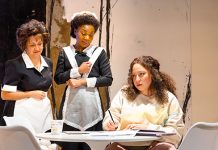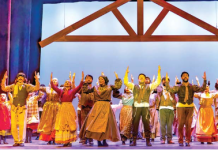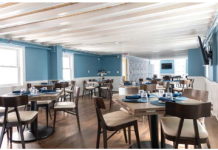By Linda McK.Stewart

In Marrakech, Morocco’s third largest city, I sit in Les Jardins de la Medina, sipping a glass of icy white wine. The city cools. The bitter orange trees are in fragrant bloom. From the nearby mosque, the plaintive call to prayer floats overhead. In this the oldest, largest private garden in Marrakech, all is at peace. I murmur a few words of appreciation for such tranquility to a friend who replies, “But this, of course, is not the true Morocco.”
“It’s not?”
“It’s Morocco, yes. But Morocco’s soul resides in the south. It’s not possible to understand Morocco, unless you know the south.”
Such were the words that sent me on a most incredible journey, undertaken in a sturdy, reliable 4×4, Tahar Najoui at the wheel, a combination in which neither my faith nor the faith of my two best-friend traveling companions was ever shaken. Departing Marrakech we plunge into the panoramic drama of the Atlas Mountains – an endless succession of towering ridges studded with massive boulders, perilously poised. It’s obvious that a mere breath could dislodge any one of them, sending it crashing into thousands of feet of emptiness. Or into us. We fear not, Tahar is with us!
We travel ever south through the Tizi-N-Tichka Pass, a narrow zigzag road that defies all laws of gravity. It was built in the 1920s by the French Foreign Legion. Great job, Beau Geste! On the high turns I spot shiny bits of sea in the west and way, way off to the south, edges of the Sahara. We hurdle past flocks of flop-eared goats. They pay us no mind.
By day’s end we’re in Ouarzazate (war-za-zat), “gateway to the Sahara,” where I hope to exercise my infant Arabic vocabulary. To my dismay Tahar tells me, “Here we speak Berber, not Arabic.” And no, Arabic and Berber are not interchangeable. The Berbers, a handsome, proud and thriving people, have existed in Morocco since the 10th century B.C. They were well established centuries before the Arabs came riding in from the east, bringing the Islamic faith with them. Most Berbers today are of the Islamic faith but they interpret the Koran with admirable tolerance. Though most Berber women cover their hair for modesty, they shun the veil or burka. To be unaware of the Berbers’ legacy to Morocco’s history is akin to believing that no one lived in America before the Pilgrims. The Berbers think of themselves, and rightly so, as the first Moroccans. It’s a claim that in 2002 took on fresh luster when King Mohammed VI married Princess Sakma Bennani, a Berber aristocrat.

We spend the night in the Berber Palace, a five-star hotel of graceful arches, crenellated walls, secluded gardens and everywhere the gentle splashing of fountains. Its style is scrupulously reflective of local casbahs that once flourished as home and fortress for families of the wealthiest tribes.
Ouarzazate sits amid some of earth’s most spectacular scenery: snow-tipped mountains, rushing waterfalls, vast stretches of impenetrable jungle, death-defying gorges, the setting for hundreds of movies, including this year’s Salmon Fishing in the Yemen. It also enjoys… how often were we told? … 300 days a year of dependable sunshine. In Ouarzazate, when myth meets reality, myth emerges triumphant, so it’s the ideal departure point for the Sahara and Erg Chebbi Golden Dunes.
From the shaded terrace of the Kasbah Hotel we peer out over an endless succession of golden brown hills and valleys, fluid ridges and hollows of fine sand, forever forming and dissolving in a whisper of wind that never ceases. As fine as sea froth, the sand is carried from crest to crest.
The sun, sliding down the western sky, bathes the whole scene in a magical gilded light. And there – straight from the Old Testament – patiently awaiting us, is our trio of camels, lying down, legs cleverly folded beneath them, heads laced in a mystery of cords and leather straps, the camel’s version of a horse’s halter. Before climbing aboard we learn how to wrap our heads in yards of blue cotton cloth, an ideal foil to sun and sand. Omar Sharif, who tells us his name is Mohammed, takes his place at the head of camel No. 1, leading our procession by a length of blue rope. We move off into the Saharan sands, devoid of even the faintest landmark. No shrub or tree, no path or rock, not so much as a twig stuck upright in the sand.
I turn for a final glimpse of the Kasbah from which we departed but already it has vanished. Sunset bleeds into twilight, twilight into moonshine. Stars sprinkle the dark dome above us and still Mohammed plods on, up one dune, down another, turning inexplicably left and minutes later, right. I sit atop a mound of folded rugs that smell deliciously of sheep and barnyards, rocking back and forth with every step, clutching what passes as metal handlebars somehow fastened to my camel’s saddle.
At last, a whiff of smoke, a pinpoint of light and there it is… our bivouac, a snug enclosure, reassuring with lantern light and the fragrance of roasting lamb. Inside our tents of plaited goat hide are thick mattresses with clean sheets and heaps of Berber wool blankets all resting on woven rugs laid atop the sand. Our mid-Sahara bathroom facilities might almost be termed luxurious.
We dine under the stars to the music of nomadic drummers, our dinner a delicious mixture of roasted meat, eggplant, couscous and a wondrous mixture of herbs. Mohammed, yes he too is Berber, tells us that we are now in a paradise of Allah’s making.
My friend in Marrakech was right. The soul of Morocco abides here in the south, safeguarded forever in the loving hands of the Berber tribes.
If you go: Details about travel in Morocco are available by contacting www.travel-exploration.com or calling 800-787-8806.














